A short history of 29 Wellington Place, Belfast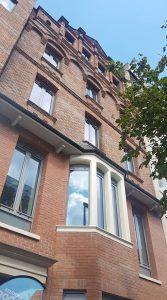
Wellington Place, being a relatively short thoroughfare from Donegall Square North to College Square East, was, like its neighbouring streets to the north, “laid out as superior terraces” in the 1790s, making it Georgian in character, rather than Victorian, as so much of the rest of Belfast is characterised by, following the expansion of the town because of the advent of the Industrial Revolution in the 1840s.
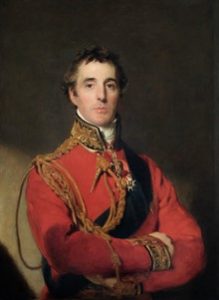
It was originally named South Parade, followed by Upper Chichester Street (after the family who held the freehold to the town of Belfast) and finally Wellington Place by 1819 – so named after the Duke of Wellington, (1769-1852) who spent part of his boyhood by the River Lagan at Annadale in South Belfast. ‘Annadale’ was named after Anna, the Duke’s mother, who was a daughter of Arthur Hill, whose family established the Downshire dynasty of Stranmillis (now Stranmillis University College) and Hillsborough Castle, now the Queen’s official residence in Northern Ireland. The Duke of Wellington was the nemesis of Napoleon, Emperor of France, whom he defeated at the Battle of Waterloo in 1815.
 These superior dwellings would have housed the burgeoning middle class, such as solicitors, merchants and physicians, who would have had several servants to tend to the family’s needs looking after a large house over four floors. Although there have been many changes to the thoroughfare over the past 200 years, three of the fine terraced houses can still be seen on the north side of the street occupied by such names as Solo Restaurant and the Oasis Gaming Centre
These superior dwellings would have housed the burgeoning middle class, such as solicitors, merchants and physicians, who would have had several servants to tend to the family’s needs looking after a large house over four floors. Although there have been many changes to the thoroughfare over the past 200 years, three of the fine terraced houses can still be seen on the north side of the street occupied by such names as Solo Restaurant and the Oasis Gaming Centre
In the early 19th century, the occupants of Wellington Place would have sent their sons to one of the most prestigious private schools in Ulster – the Royal Belfast Academic Institution (also known as Inst) which was located at College Square at the top of the thoroughfare. The main part of the building was completed in 1814 and its classical façade still stands today behind John Bell House.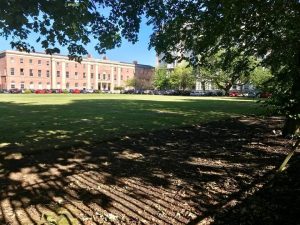
However, as the century progressed, Wellington Place ceased to be exclusively residential and many of the houses were gradually converted for commercial use.

The Evangelical Union Church of 1858 (now Roost Coffee), which served the local population was demolished by 1895, and soon ornate linen warehouses such as that of James & Robert Young (on the corner of Queen Street) were being built along the thoroughfare. By 1850 Belfast was fast becoming the largest producer of linen products in the world, exporting to every corner of the globe such as the United States; South America; Australia and South Africa.
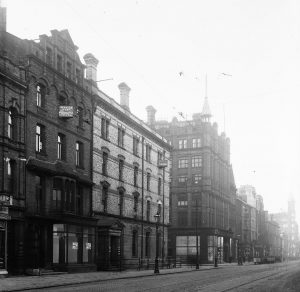 It was against this dramatic change in urban living that a property developer of the time, acting on behalf of a private client, acquired a narrow plot of land in 1885 next to Young’s Linen Warehouse for the purposes of erecting a four-storey building which would service the needs of an ever-expanding metropolis. It was built of red brick over five floors with a distant ornamental gable. When it was finished it was one of the tallest buildings on the street and must have looked very impressive compared to the Monumental Sculptor’s Yard which stood on the site before. It was designed as a private residence over 5 floors … but who could afford to have such a sizeable property designed for their own use?
It was against this dramatic change in urban living that a property developer of the time, acting on behalf of a private client, acquired a narrow plot of land in 1885 next to Young’s Linen Warehouse for the purposes of erecting a four-storey building which would service the needs of an ever-expanding metropolis. It was built of red brick over five floors with a distant ornamental gable. When it was finished it was one of the tallest buildings on the street and must have looked very impressive compared to the Monumental Sculptor’s Yard which stood on the site before. It was designed as a private residence over 5 floors … but who could afford to have such a sizeable property designed for their own use?
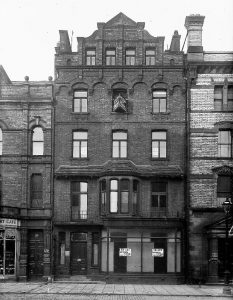 The first occupant of 29 Wellington Place in 1885, was Doctor Joseph Nelson, MD; L.R.C.S.I (Licentiate of the Royal College of Surgeons of Ireland). This was no surprise as the area around RBAI (Inst) on College Square was known as the ‘Harley Street’ of Belfast. Dr Nelson would have used the ground floor as his consulting rooms and used the upper floors as his private residence. Two doors up, was the residence of Dr. J. Cumins, Professor of Medicine at Queen’s College (now Queen’s University), so the importance of the area by the time Queen Victoria bestowed the Charter of a City upon Belfast in1888 should not be underestimated.
The first occupant of 29 Wellington Place in 1885, was Doctor Joseph Nelson, MD; L.R.C.S.I (Licentiate of the Royal College of Surgeons of Ireland). This was no surprise as the area around RBAI (Inst) on College Square was known as the ‘Harley Street’ of Belfast. Dr Nelson would have used the ground floor as his consulting rooms and used the upper floors as his private residence. Two doors up, was the residence of Dr. J. Cumins, Professor of Medicine at Queen’s College (now Queen’s University), so the importance of the area by the time Queen Victoria bestowed the Charter of a City upon Belfast in1888 should not be underestimated.
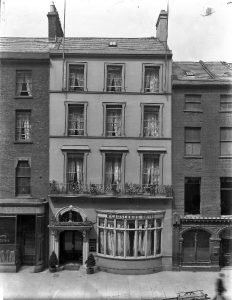 By 1901, Wellington Place was further becoming more commercial in nature. The former large houses were further converted for use as small hotels to serve the thousands of travellers arriving into the Great Northern Railway terminus (the main line from Dublin) on Great Victoria Street (now the site of the Europa Hotel). It was however chosen as the location for the City of Belfast YMCA, an enormously important organisation of the time for the development of young people by the Church of Ireland. It housed the Café Royale, one of the largest and most important meeting places for the people of Belfast.
By 1901, Wellington Place was further becoming more commercial in nature. The former large houses were further converted for use as small hotels to serve the thousands of travellers arriving into the Great Northern Railway terminus (the main line from Dublin) on Great Victoria Street (now the site of the Europa Hotel). It was however chosen as the location for the City of Belfast YMCA, an enormously important organisation of the time for the development of young people by the Church of Ireland. It housed the Café Royale, one of the largest and most important meeting places for the people of Belfast.
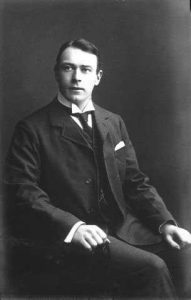 One significant lodger at the home of Dr and Mrs Nelson was a young man from Comber, Co Down, by the name of Thomas Andrews. Although he came from a wealthy background, Thomas entered the shipyard of Harland & Wolff as a ‘gentleman’s appretice’ in 1889. Part of his training was to attend the nearby Municipal College of Technology (now John Bell House) when he studied maritime architecture. In order to do so, he stayed up in Belfast during the week at Wellington Place on the top floor of No 29, returning to Comber by train at the weekends. His studies led him to become a member of the Institution of Naval Architects, after which he became Managing Director of Drafting at Harland & Wolff. Thomas Andrews is best remembered as being the Chief Designer for RMS Titanic, built at Harland & Wolff for the White Star Line in 1912. He was selected to be part of the ‘guarantee group’ aboard RMS Titanic when she set off on her maiden voyage, but was lost at sea along with 1500 other passengers and crew when the ship sank in the early morning of April 11, 1912. The rest is legend …
One significant lodger at the home of Dr and Mrs Nelson was a young man from Comber, Co Down, by the name of Thomas Andrews. Although he came from a wealthy background, Thomas entered the shipyard of Harland & Wolff as a ‘gentleman’s appretice’ in 1889. Part of his training was to attend the nearby Municipal College of Technology (now John Bell House) when he studied maritime architecture. In order to do so, he stayed up in Belfast during the week at Wellington Place on the top floor of No 29, returning to Comber by train at the weekends. His studies led him to become a member of the Institution of Naval Architects, after which he became Managing Director of Drafting at Harland & Wolff. Thomas Andrews is best remembered as being the Chief Designer for RMS Titanic, built at Harland & Wolff for the White Star Line in 1912. He was selected to be part of the ‘guarantee group’ aboard RMS Titanic when she set off on her maiden voyage, but was lost at sea along with 1500 other passengers and crew when the ship sank in the early morning of April 11, 1912. The rest is legend …
 Dr Nelson happily remained at his consulting rooms and residence at 29 Wellington Place but nearby, one major change in the area in 1906, saw his fellow physicians and surgeons on College Square leave the area in large numbers – the building of the Municiple College of Technology (now John Bell House) in the grounds of Royal Belfast Academical Institution. RBAI had almost gone bankrupt, and in a desperate attempt to raise funds, sold off the former lawns of the school to the Corporation of Belfast for the building of the new college. The surgeons and physicians felt that the area had degenerated as a result and they took themselves off to University Square beside Queen’s University which they considered to be much more prestigious.
Dr Nelson happily remained at his consulting rooms and residence at 29 Wellington Place but nearby, one major change in the area in 1906, saw his fellow physicians and surgeons on College Square leave the area in large numbers – the building of the Municiple College of Technology (now John Bell House) in the grounds of Royal Belfast Academical Institution. RBAI had almost gone bankrupt, and in a desperate attempt to raise funds, sold off the former lawns of the school to the Corporation of Belfast for the building of the new college. The surgeons and physicians felt that the area had degenerated as a result and they took themselves off to University Square beside Queen’s University which they considered to be much more prestigious.
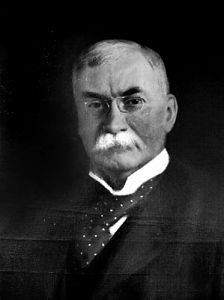 29 Wellington Place remained the residence of Dr Joseph Nelson from 1885 until his death on 31 August 1910. His importance to the medical profession in Ireland was enormous, serving as President of the Ulster Medical Council for the session 1898-1899. However, as a young man, and after studying at Queen’s, he set sail for Italy where he obtained a commission from Garibaldi’s “Regimento Inglese” to fight for Italy’s unification. He was later presented with two medals for gallantry by the King of Italy. After gaining his MD at the University of Ireland in 1863, he once again took off, this time to India, where he became a surgeon on a tea plantation before becoming a tea planter in his own right. He returned to Belfast in 1885, where he was appointed the first ophthalmic surgeon to the Royal Hospital, where he held classes for students at 8:00 am daily. He regularly entertained his fellow surgeons and members of the Ulster Medical Society with his wife, Elizabeth at 29 Wellington Place over a period of 25 years. They had two daughters and one son, and lived comfortably with a staff of 4 servants: a housekeeper, a nurse and two domestic servants.
29 Wellington Place remained the residence of Dr Joseph Nelson from 1885 until his death on 31 August 1910. His importance to the medical profession in Ireland was enormous, serving as President of the Ulster Medical Council for the session 1898-1899. However, as a young man, and after studying at Queen’s, he set sail for Italy where he obtained a commission from Garibaldi’s “Regimento Inglese” to fight for Italy’s unification. He was later presented with two medals for gallantry by the King of Italy. After gaining his MD at the University of Ireland in 1863, he once again took off, this time to India, where he became a surgeon on a tea plantation before becoming a tea planter in his own right. He returned to Belfast in 1885, where he was appointed the first ophthalmic surgeon to the Royal Hospital, where he held classes for students at 8:00 am daily. He regularly entertained his fellow surgeons and members of the Ulster Medical Society with his wife, Elizabeth at 29 Wellington Place over a period of 25 years. They had two daughters and one son, and lived comfortably with a staff of 4 servants: a housekeeper, a nurse and two domestic servants.
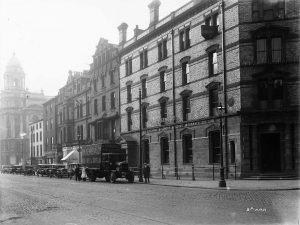 By the 1920s and 30s, Wellington Place had secured for itself a prominent place in the commercial life of the city. Many of the leading architects who shaped the face of Belfast had their offices here, in addition to the leading insurance companies of the day, distributors, stock and share brokers and solicitors. Mrs Nelson sold up following the death of her husband and what had previously been a family residence was converted into showrooms for Craig & Paton, Ltd., Laundry, Electrical and General Engineers: Telegraphic Address, “Rotary, Belfast” with the upper floor being occupied by the offices of the Belfast War Pensions’ Committee. The ground floor (which today has been authentically restored for Student Roost) had a modern 1920’s shop front added, but the building retained its unique first floor ‘running’ roof.
By the 1920s and 30s, Wellington Place had secured for itself a prominent place in the commercial life of the city. Many of the leading architects who shaped the face of Belfast had their offices here, in addition to the leading insurance companies of the day, distributors, stock and share brokers and solicitors. Mrs Nelson sold up following the death of her husband and what had previously been a family residence was converted into showrooms for Craig & Paton, Ltd., Laundry, Electrical and General Engineers: Telegraphic Address, “Rotary, Belfast” with the upper floor being occupied by the offices of the Belfast War Pensions’ Committee. The ground floor (which today has been authentically restored for Student Roost) had a modern 1920’s shop front added, but the building retained its unique first floor ‘running’ roof.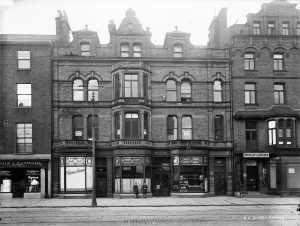
Next Door was the quirkily named “Merrythought Café” – one of the social hubs of ‘Roaring Twenties’ Belfast. It was “the” place to be seen and many large companies and organisations holding their staff balls and presentations at the premises next door to Number 29 Wellington Place.
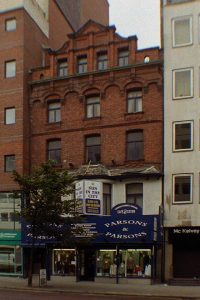 During the war years, many different organisations and professions occupied the 5 floors of 29 Wellington Place. Due to aerial bombing of Belfast during the Second World War, many businesses had to relocate from their destroyed premises, one being Robert Patterson & Sons whose Bridge Street store was destroyed in the Luftwaffe Blitz of Easter Monday, 1941. Patterson’s were Ironmongers, Mill Furnishers, Ship Furnishers, and Engineers and traded on Wellington Place until their premises were rebuilt in 1946.
During the war years, many different organisations and professions occupied the 5 floors of 29 Wellington Place. Due to aerial bombing of Belfast during the Second World War, many businesses had to relocate from their destroyed premises, one being Robert Patterson & Sons whose Bridge Street store was destroyed in the Luftwaffe Blitz of Easter Monday, 1941. Patterson’s were Ironmongers, Mill Furnishers, Ship Furnishers, and Engineers and traded on Wellington Place until their premises were rebuilt in 1946.
From 1932 to 1960 the ground floor of 29 Wellington Place was occupied by the family firm of W. G. Wilson & Sons, Solicitors – (W. G. Wilson, W. G. Wilson, jun., Commissioner for Oaths; George I. Wilson; Gerard D. Wilson). The Wilsons had an extensive practice in the city with many major clients.
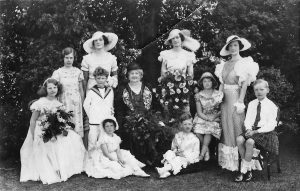 It was in 1960, that the most significant change of occupier took place, when the established firm of Parsons & Parsons (Tailors) moved in to 29 Wellington Place. Parsons & Parsons had been established further along Wellington Place (at Number 37) in 1909 as Ladies and Gents Tailors. As a formal clothing hire company, it dressed the citizens of Belfast seeking to outshine others at special occasions for more than a century. The company specialised in weddings, formal wear, ladies, Highland and bespoke clothing. Whether it was formal attire for a gala ball, a cruise or a college formal, the hire store close to City Hall seemed to cater for whatever was needed. It stocked fine suits, waistcoats, dinner jackets and bow ties, as well as evening dresses, lingerie and kilts. In addition to this it offered customers a tradition bespoke service, with specialist tailors creating jackets, suits, trousers or coats all crafted to customers’ specifications – or waist size. It also provided a service selling barristers’ court suits and accessories.
It was in 1960, that the most significant change of occupier took place, when the established firm of Parsons & Parsons (Tailors) moved in to 29 Wellington Place. Parsons & Parsons had been established further along Wellington Place (at Number 37) in 1909 as Ladies and Gents Tailors. As a formal clothing hire company, it dressed the citizens of Belfast seeking to outshine others at special occasions for more than a century. The company specialised in weddings, formal wear, ladies, Highland and bespoke clothing. Whether it was formal attire for a gala ball, a cruise or a college formal, the hire store close to City Hall seemed to cater for whatever was needed. It stocked fine suits, waistcoats, dinner jackets and bow ties, as well as evening dresses, lingerie and kilts. In addition to this it offered customers a tradition bespoke service, with specialist tailors creating jackets, suits, trousers or coats all crafted to customers’ specifications – or waist size. It also provided a service selling barristers’ court suits and accessories.
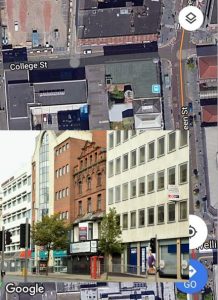 Sadly, after 104 years of trading on Wellington Place, Parsons & Parsons closed in November 2013. The building which had served so many different people lay empty and neglected. It was a significant property extending from Wellington Place to College Street and sharing a boundary with another historic property at 41- 49 Queen Street known as Swanston’s buildings. When the building came up for auction in 2015, a joint property deal was done to acquire both buildings for the provision of a major student accommodation development which would incorporate both sites, but at the same time retaining the historic facades of both properties.
Sadly, after 104 years of trading on Wellington Place, Parsons & Parsons closed in November 2013. The building which had served so many different people lay empty and neglected. It was a significant property extending from Wellington Place to College Street and sharing a boundary with another historic property at 41- 49 Queen Street known as Swanston’s buildings. When the building came up for auction in 2015, a joint property deal was done to acquire both buildings for the provision of a major student accommodation development which would incorporate both sites, but at the same time retaining the historic facades of both properties.
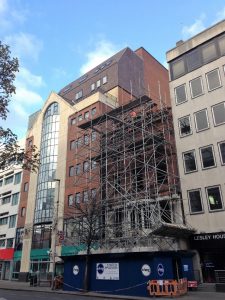 Plans were drawn up create a purpose-built managed student accommodation (PBSA) comprising 114 studios and 203 cluster rooms (317 units in total) to be named Swanston House with its main entrance at 29 Wellington Place.
Plans were drawn up create a purpose-built managed student accommodation (PBSA) comprising 114 studios and 203 cluster rooms (317 units in total) to be named Swanston House with its main entrance at 29 Wellington Place.
The historic façade that was created as the residence for Dr Joseph Nelson in 1890 was secured using the latest construction methods, whilst the rear of the building was demolished and rebuilt, providing some of the best student accommodation in the city. The ugly and intrusive 1960s shop front was removed and a replica of the original doorway and bay windows on the ground and first floors reinstated as it would have looked in 1890.
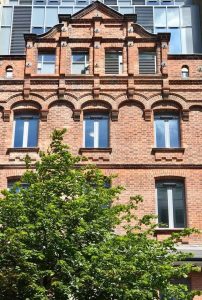 Swanston House, managed by Student Roost, opened in August 2018 at 29 Wellington Place.
Swanston House, managed by Student Roost, opened in August 2018 at 29 Wellington Place.
… You’re more than welcome!
© Researched and compiled by History Hub Ulster Member Richard Graham | August 2018
